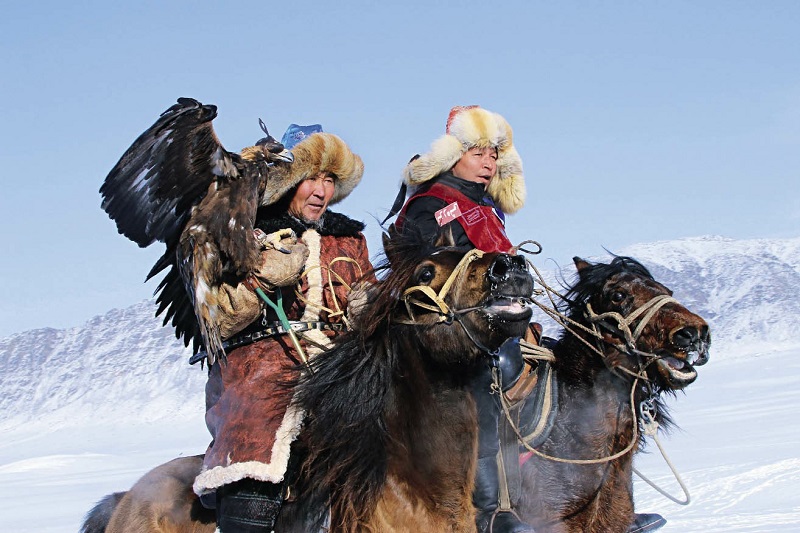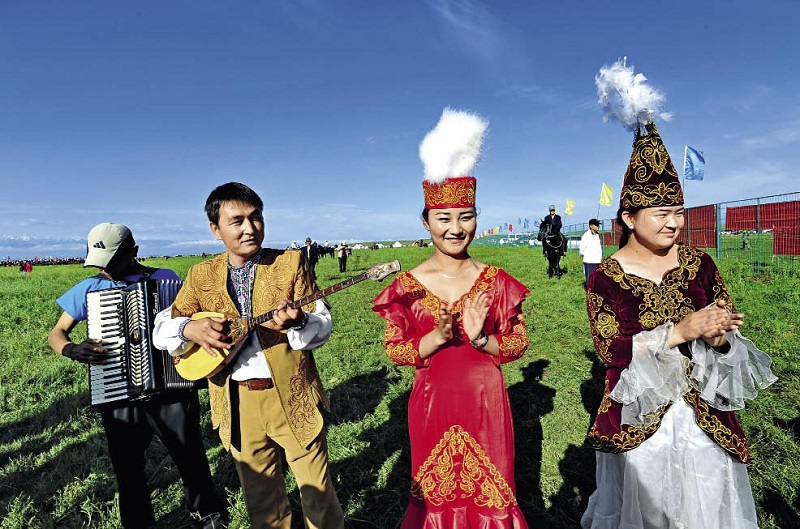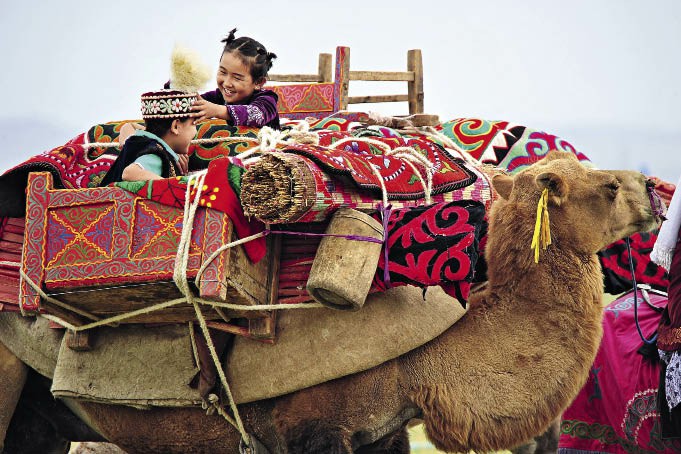
Falcons are favorite birds of Kazakh herdsmen.
THE people of the Kazakh ethnic minority in China are principally distributed in Mori and Barkol Kazakh autonomous counties in Xinjiang Uygur Autonomous Region and Aksay Kazakh Autonomous County in Gansu Province. From ancient times to the present day, the ethnic Kazakhs have occupied themselves with an animal husbandry economy, while living a nomadic life. Over the long evolution process, their folk costumes have gradually changed to meet the needs of nomadic migration in the mountain grasslands, resulting in the formation of both a practical and attractive style that incorporates the group’s history.
The material selection of Kazakh attire is related to local production and life. Wildlife and livestock are abundant in the pastoral areas, so the raw materials of clothing include wild animal skins and livestock skins. Clothing materials can be divided into leather and cloth. Generally, they wear leather clothes in spring and winter and cotton clothes in summer and autumn. When making leather garments, they first use a fermentation agent to transform leather into a processed hide and then color dye them. The processed leather is then used to make overcoats, sleeveless jackets, and drop crotch pants. Affluent families used lambskins, ponyskins, even wolf and fox skins as raw materials.
Kazakh men’s clothing mainly includes fur coats, leather trousers, shirts, trousers, sleeveless jackets, and robes that button down in front, and the color is mostly gray or brown. All are relatively loose, as being loose and sturdy are convenient for riding and herding. When overseeing grazing livestock in winter, men often wear a kind of fur coat with a woollen lining, ideal to keep warm. A relatively wide cowhide belt is tied around the waist, often decorated with assorted gems. The waist is equipped with an exquisite knife, presenting the overall image of a powerful man symbolic of the nomadic people. A loose coat is also usually worn in winter, covered with a layer of wool or camel hair.
Ethnic Kazakhs often wear long vests in summer and autumn. This traditional garment is made of velveteen, velvet or corduroy, which widens below the waist and flares out to reach the knees. Men’s long vests are decorated with lace, while women’s long vests are covered with diverse flower patterns on the open front. Apart from the long vests, the clothes often worn in summer and autumn are shirts, sleeveless jackets, long trousers, and robes buttoning down the front. The shirts and trousers are mostly made of white cloth. The shirt is a high collar pullover style. The shirts of young men are often embroidered with multicolored patterns on the collar, demonstrating vitality.

Aken is the name Kazakh people call folk rap artists, singers, and poets. The oral literature of Kazakhs, including many ancient narrative poems, stories, and proverbs, has been preserved by Aken’s oral transmission from generation to generation.
Kazakh women’s clothing is distinct from men’s wear, being more colorful and decorative. Women often wear sleeveless jackets and long dresses, while girls wear short skirts. Sleeveless jackets can be divided into many categories. Classified by the seasons, there are summer and winter varieties. Classified by styles, they can be long or short. When subdivided, there are multiple styles, including round necklines, triangular necklines, straight tube styles, and fitted waist styles. The fabrics of sleeveless jackets are usually velvet, cashmere, and velveteen in all colors. There are assorted flower patterns and geometric patterns embroidered on both sides of the lapel; colorful buttons, silver ornaments, silver coins, and other decorations are fastened at the chest, making a pleasant jingling sound when walking.
Kazakh women’s flowing dresses are mostly made of light blue, green, red, and white satin. The sleeves are embroidered with flowers, and the hem is decorated with multi-layered lotus leaves. The colors of the dresses are in harmony with surroundings of the pastoral region, looking elegant and dignified. When adolescent Kazakh girls in long dresses stand on the expansive grassland, they resemble mountain flowers in full bloom, dancing with the wind, brimming with youthful vigor. The dresses of married women are more plain than that of single girls. Despite still wearing dresses and sleeveless jackets, they do not carry any ornaments on the chest, which signals the maturity and dignity of wives. Older women wear loose pleated dresses concealing their whole body, made of light colored cloth or dark colored silk fabrics, with stand-up collars, embroidered with geometric patterns, and normally reach the knee.

Kazakh children taking a journey on camelback.
Hats and scarves are the most common headwear for Kazakhs, with women’s headwear being more delicate. Young Kazakh girls usually wear a triangular or square headdress in summer, profusely decorated with flower designs. In winter, they usually dress up in hard shell bowler hats, with bead ornaments and owl feathers on the top of the hats, signifying a resolute and valiant spirit, and implying happiness. Girls, when getting married, wear high pointed caps, embroidered with flowers and decorated with gold and silver jewelry. The front of the hats are embellished with beads hanging in front of their faces, making the brides appear bashful. Kazakh women should wear headscarves after they get married. In the first year of marriage, most of the scarves are made of red silk, thereafter changing to a loose scarf made of embroidered white cloth that only displays the face. In addition, a large scarf should be worn on the shoulder. The scarves of young or middle-aged women are gaily-colored, of fine workmanship, embroidered with lovely patterns and flowers. According to the conventional customs of the ethnic Kazakhs, women’s hats, headscarves, and shawls should never be removed in front of the mother-in-law’s family or in front of unfamiliar males. Men and women must wear hats in winter and summer. They cannot wear brightly colored headscarves within a year following the death of a family member, but should instead wear specially designed headscarves.
Ethnic Kazakhs are fond of wearing durable leather boots. The high boots are worn with durable socks, which are edged with flannel and artistic designs. In addition, there is a kind of soft boot without a heel, equipped with a covering to protect the boots from being soaked with rain or snow. Women’s shoes and boots are made in diverse colors, inlaid with jewels, gold and silver pieces, pearls or other decorations. The shoes are also embroidered with delicate and fine designs. The colors of leather boots worn by girls are varied, including a diverse spectrum of red, brown, blue, black, white, and other colors.
Kazakh clothing and its style, pattern, and color codes are part of their ethnic aesthetic appeal, sufficiently mirroring the essence and character of the people. Their attire has been, and will continue to be, an integral part of China’s traditional clothing culture.